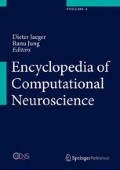Access this chapter
Tax calculation will be finalised at checkout
Purchases are for personal use only
References
Amari S (1975) Homogeneous nets of neuron-like elements. Biol Cybern 17:211–220
Amari S (1977) Dynamics of pattern formation in lateral-inhibition type neural fields. Biol Cybern 27:77–87
Ashby W (1950) The stability of a randomly assembled nerve-network. Electroencephalogr Clin Neuro-Physiol 2:471–482
Beurle R (1956) Properties of a mass of cells capable of regenerating pulses. Philos Trans R Soc B 240:55–94
Bojak I, Liley D (2005) Modeling the effects of anesthesia on the electroencephalogram. Phys Rev E 71:041,902
Bressloff P (2012) Spatiotemporal dynamics of continuum neural fields. J Phys A Math Theor 45:033001
Cragg B, Temperley H (1954) The organization of neurones: a co-operative analogy. Electroencephalogr 6:85–92
Deco G, Jirsa V, Robinson P, Breakspear M, Friston K (2008) The dynamic brain: from spiking neurons to neural masses and cortical fields. PLoS Comput Biol 4:e1000,092
De-Miguel FF, Fuxe K (2012) Extrasynaptic neurotransmission as a way of modulating neuronal functions. Front Physiol 3:16
Ermentrout B (1998) Neural networks as spatio-temporal pattern-forming systems. Rep Prog Phys 61:353–430
Foster B, Bojak I, Liley D (2008) Population based models of cortical drug response: insights form anaesthesia. Cogn Neurodyn 2:283–296
Freeman W (1964) A linear distributed feedback model for prepyriform cortex. Exp Neurol 10:525–547
Freeman W (1967) Analysis of function of cerebral cortex by use of control systems theory. Logistics Rev 3:5–40
Freeman W (1975) Mass action in the nervous system: examination of the neurophysiological basis of adaptive behavior through the EEG, 1st edn. Academic, New York, also electronic edition. http://sulcus.berkeley.edu/MANSWWW/MANSWWW.html, 2004
Freeman WJ (1979) Nonlinear gain mediating cortical stimulus–response relations. Biol Cybern 33:237–247
Giaume C, Koulako A, Roux L, Holcman D, Rouach N (2010) Astroglial networks: a step further in neuroglial and gliovascular interactions. Nat Rev Neurosci 11:87–99
Grossberg S (1967) Nonlinear difference-differential equations in prediction and learning theory. Proc Natl Acad Sci U S A 58:1329–1334
Jansen B, Rit V (1995) Electroencephalogram and visual evoked potential generation in a mathematical model of coupled cortical columns. Biol Cybern 73:357–366
Liley D, Cadusch P, Da lis M (2002) A spatially continuous mean field theory of electrocortical activity. Netw Comput Neural Syst 13:67–113
Liley D, Cadusch P, Gray M, Nathan P (2003) Drug-induced modification of the system properties associated with spontaneous human electroencephalographic activity. Phys Rev E 68:051,906
Liley D, Bojak I, Foster B (2012) Co-operative populations of neurons: mean field models of mesoscopic brain activity. In: Le Novere N (ed) Computational systems neurobiology. Springer, New York, pp 317–364
Longtin A (2013) Neuronal noise. Scholapedia 8(9):1618
Lopes da Silva F, Hoeks A, Smits H, Zetterberg L (1974) Model of brain rhythmic activity: the alpha-rhythm of the thalamus. Kybernetik 15:27–37
Lytton WW (2008) Computer modelling of epilepsy. Nat Rev Neurosci 9(8):626–637
McCulloch W, Pitts W (1943) A logical calculus of the ideas immanent in nervous activity. Bull Math Biophys 5:155–133
Moran R, Stephan K, Seidenbecher T, Pape H, Dolan R, Friston K (2009) Dynamic causal models of steady-state responses. Neuroimage 44:796–811
Mozzachiodi R, Byrne JH (2010) More than synaptic plasticity: role of nonsynaptic plasticity in learning and memory. Trends Neurosci 33(1):17–26
Rall W (1967) Distinguishing theoretical synaptic potentials computed for different soma-dendritic distributions of synaptic input. J Neurophysiol 30:1138–1168
Rapoport A (1950) Contribution to the probabilistic theory of neural nets: I. randomization of refractory periods and of stimulus intervals. Bull Math Biophys 12:109–121
Robinson P, Rennie C, Rowe D (2002) Dynamics of large-scale brain activity in normal arousal states and epileptic seizures. Phys Rev E 65:041,924
Sleigh J, Voss L, Steyn-Ross M, Steyn-Ross D, Wilson M (2011) Modelling sleep and general anaesthesia. In: Hutt A (ed) Sleep and anaesthesia: Neural correlates in theory and experiment. Springer, New York, pp 21–41
Softky WR, Koch C (1993) The highly irregular ring of cortical cells is inconsistent with temporal integration of random EPSPs. J Neurosci 13:334–350
Sohl G, Maxeiner S, Willecke K (2005) Expression and functions of neuronal gap junctions. Nat Rev Neurosci 6(3):191–200
Steyn-Ross M, Steyn-Ross D, Sleigh J, Liley D (1999) Theoretical electroencephalogram stationary spectrum for a white-noise-driven cortex: evidence for a general anesthetic-induced phase transition. Phys Rev E 60:7299–7311
Stys PK (2011) The axo-myelinic synapse. Trends Neurosci 34(8):393–400
Terzuolo CA, Bullock TH (1956) Measurement of imposed voltage gradient adequate to modulate neuronal ring. Proc Natl Acad Sci U S A 42(9):687–694
van Veen L, Liley D (2006) Chaos via Shilnikov’s saddle-node bifurcation in a theory of the electroencephalogram. Phys Rev Lett 97:208,101
Wilson H, Cowan J (1972) Excitatory and inhibitory interactions in localized populations of model neuron. Biophys J 12:1–24
Wilson H, Cowan J (1973) A mathematical theory of the functional dynamics of cortical and thalamic nervous tissue. Kybernetik 13:55–80
Author information
Authors and Affiliations
Corresponding author
Editor information
Editors and Affiliations
Rights and permissions
Copyright information
© 2015 Springer Science+Business Media New York
About this entry
Cite this entry
Liley, D.T.J. (2015). Neural Population Model. In: Jaeger, D., Jung, R. (eds) Encyclopedia of Computational Neuroscience. Springer, New York, NY. https://doi.org/10.1007/978-1-4614-6675-8_69
Download citation
DOI: https://doi.org/10.1007/978-1-4614-6675-8_69
Published:
Publisher Name: Springer, New York, NY
Print ISBN: 978-1-4614-6674-1
Online ISBN: 978-1-4614-6675-8
eBook Packages: Biomedical and Life SciencesReference Module Biomedical and Life Sciences

